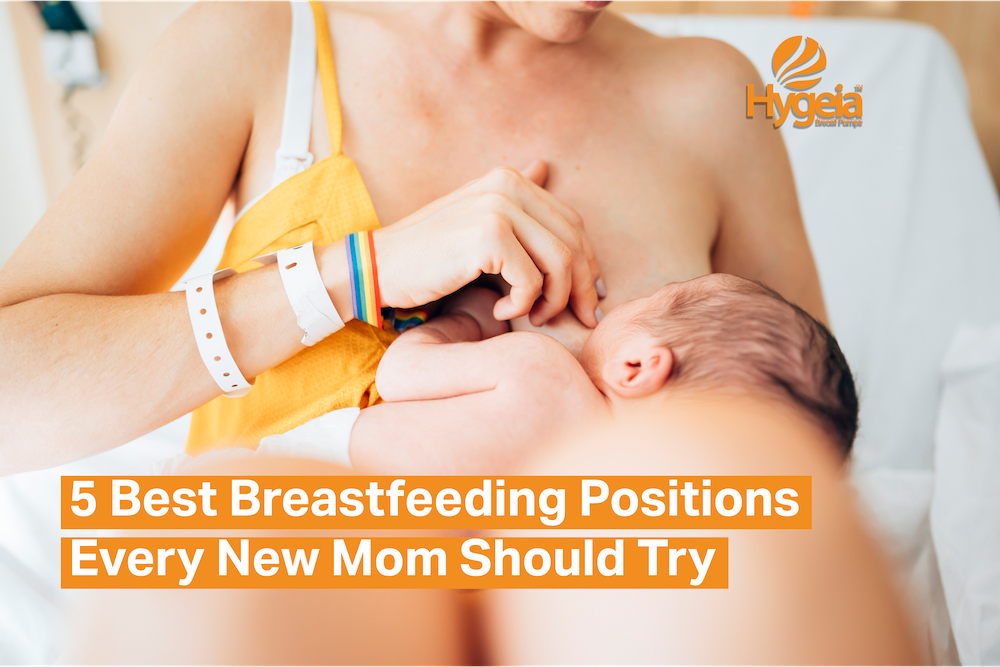Finding the breastfeeding position can make all the difference in your comfort and your baby’s feeding success. Every mother and baby pair is unique, so what feels natural to one person might not work for another. The key is to experiment, stay relaxed, and choose positions that help your baby latch deeply while keeping you both comfortable.
Below are some of the best breastfeeding positions to try—each one with its own advantages depending on your body, your baby’s age, and your feeding goals. As you try different holds, it doesn’t hurt to ask for help from someone with experience to be sure you are getting them right. A nursing pillow can give you more freedom to get yourself and baby comfortable as these positions become more natural to you both.
1. The Cradle Hold
The cradle hold is one of the most classic breastfeeding positions and often the one new mothers try first.
How to do it:
- Sit upright in a comfortable chair or on a supportive bed.
- Hold your baby so their head rests in the bend of your arm, with their body turned toward you.
- Make sure your baby’s nose is level with your nipple and their head, neck, and body are aligned in a straight line.
Why it works: This position promotes closeness and eye contact. It’s ideal once your baby has developed a stronger neck and feeding rhythm. For newborns, it may take a little more coordination, so don’t be discouraged if it’s tricky at first.
Tip: Support your arm with a nursing pillow or rolled-up blanket to reduce shoulder and wrist strain.
2. The Cross-Cradle Hold
The cross-cradle hold is similar to the cradle hold but gives you more control over your baby’s head and latch—making it perfect for newborns or babies who need a little help getting a deep latch.
How to do it:
-
Sit upright and hold your baby across your body, tummy to tummy.
-
Support their neck and shoulders with the hand opposite to the breast you’re feeding from (for example, use your right hand for your baby’s head when nursing on the left breast).
-
Use your free hand to guide your breast and help your baby latch.
Why it works: This position lets you guide your baby’s mouth precisely to the nipple and adjust as needed for a better latch. It’s especially useful during the early weeks when you’re both still learning.
3. The Football Hold (Clutch Hold)
If you’ve had a cesarean birth or have larger breasts, this position can be a game-changer.
How to do it:
-
Tuck your baby under your arm like a football, with their legs pointing toward your back.
-
Support their head and shoulders with your hand and use a pillow under your arm for comfort.
-
Bring your baby’s mouth to your nipple, keeping their nose clear for easy breathing.
Why it works: It keeps pressure off your abdomen, supports smaller or premature babies, and helps you see your baby’s latch clearly. Many moms find it easier to maintain a deep latch in this position.
4. The Side-Lying Position
This one’s all about rest and relaxation—perfect for nighttime feedings or when you need to recover post-delivery.
How to do it:
-
Lie on your side with your baby facing you, tummy to tummy.
-
Support your head with a pillow and use another behind your baby’s back to keep them close.
-
Bring your baby’s nose to your nipple and allow them to latch naturally.
Why it works: You can rest your body while your baby feeds, and it’s gentle on your healing body after birth or a C-section.
5. The Laid-Back (Biological Nurturing) Position
This position takes advantage of gravity and your baby’s natural feeding instincts.
How to do it:
-
Recline comfortably on a couch or bed at about a 45-degree angle.
-
Place your baby tummy down on your chest, with their head near your breast.
-
Support your baby as they find the nipple and begin to nurse.
Why it works: This position encourages your baby to use their reflexes to find the breast and latch deeply. It also reduces nipple pain and helps milk flow naturally.
Comfort Tips for Every Position
No matter which position you choose, comfort for both you and your baby is essential. Here’s how to make feeding smoother:
-
Use pillows or cushions to support your arms, baby, and back.
-
Bring your baby to your breast, not your breast to your baby. Hunching forward can lead to back and neck pain.
-
Check for a good latch. Your baby’s mouth should cover most of the areola, not just the nipple.
-
Switch sides each feeding or halfway through to keep milk production balanced.
-
Stay hydrated and relaxed. Deep breathing before and during feeds can help your milk let down more easily.
- Ask for help. A lactation consultant can help you get comfortable or adjust your latch and hold appropriately, but even an experienced breastfeeding mom can be of great assistance.
Final Thoughts
Breastfeeding takes patience, practice, and a bit of trial and error. The “best” position is the one that feels right for both of you—one that supports your baby’s latch and your body’s comfort.
If you’re experiencing pain, soreness, or latch difficulties, don’t hesitate to reach out to a lactation consultant or your healthcare provider. Sometimes small adjustments make a big difference.
At Hygeia Health, we believe that comfortable, confident breastfeeding starts with the right support—both in guidance and in tools like our hospital-grade breast pumps. With knowledge, patience, and the right equipment, you can make breastfeeding a more enjoyable and successful experience for both you and your baby. Apply today to let Hygeia assist in getting your high quality breast pump covered 100% by your insurance.

